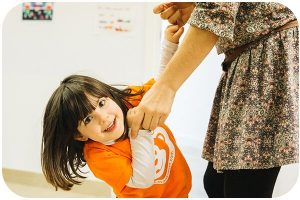When I was nine years old, an American boy named Kyle moved to our neighborhood in suburban Stockholm. When we met him, my best friend Gustaf immediately switched to English. I had never heard him speak much English before, but Gustaf had spent a couple of years in an American school in Germany and spoke it fluently. I only knew a few English words, but I don’t remember it ever being a problem. We played well, and I always had a translator in my friend Gustaf. That’s how I learned English—playing. Not all children have it this easy.
A growing population of English learners

There is an ever-growing number of students in the U.S. school system for whom English is their second language. An estimated 25 percent of children are from immigrant families and live in households where a language other than English is spoken, according to the Center for American Progress. That means that when these children start kindergarten, many don’t speak English yet.
Children who come from homes where English is a second language fare far worse on standardized tests throughout their schooling and are four times as likely to drop out of high school as compared to other populations.
English as a Second Language (ESL) students need extra assistance, but just one percent of teachers are qualified to instruct them. In essence, this means there is one ESL instructor for every 150 ESL students. Public schools could never hire enough teachers to meet the demand for instruction. Teaching power is expensive. Learning power on the other hand isn’t. Every student has it!
The natural solution
Sometimes there is an overlooked natural solution to problems that we try to solve through technology, institutionalizing, medication, therapy, or other means developed by professionals. I believe that children’s language learning is precisely such an area where a hands-off approach would be faster, less expensive, and more confidence-building for all involved.
So what can we do? Here’s a radical idea. Let the children play! Most children in America learn English through their natural curiosity, through play, exploration, and immersion. The best thing we could do is to give the young children of immigrants a chance to do the same.
Kindergarten used to be play-based!
The kindergarten year is when the number of children who do not yet speak English are the highest. It is also the grade that has seen the biggest decrease in play time.
Kindergartners today are writing sentences, learning history, studying geography, and doing simple math problems. Today’s kindergarten curriculum is more like a first grade curriculum of the past, and there is little evidence it’s helping in the long run.
Learning to read early helps with literacy and writing skills in the short perspective, of course, but studies show that children who have been allowed more time to play catch up in a few years—and even pass their peers who have been forced to learn to read and write early.
Even children of English speaking parents will benefit from play as it helps promote socio-emotional and physical development. While playing, children also practice creative and problem-solving skills, learn how to cooperate and share, develop empathy, and learn self control.
The future
When Kyle, Gustaf, and I were playing, a quick calculation showed that English should be the lingua franca of our group. Kyle went back to the United States without having learned much Swedish, and knowing he’d never use it back home, I can’t blame him for not being that interested.
Many bilingual school programs experience the same thing. If slightly more than half of students speak one language it quickly becomes the default means of communication for play.
Most schools in the U.S. have a majority of students who come from English speaking families. This means that for every child who wants to learn English, like me, there are seven monolinguals, like Kyle, and one bilingual, potential translator, like Gustaf.
We stand to save billions of dollars by increasing play time and letting the Kyles and the Gustafs of the world help out our ESL teachers who couldn’t do half as well. Even if by some miracle we managed to find enough of them.
The only thing we have to do is increase play and social time for all students.
Who’s game?!
 Jens Peter de Pedro is Play Advocate and Experience Director at Monkimun, makers of Lingokids.com. Follow him @jp_de_pedro.
Jens Peter de Pedro is Play Advocate and Experience Director at Monkimun, makers of Lingokids.com. Follow him @jp_de_pedro.

